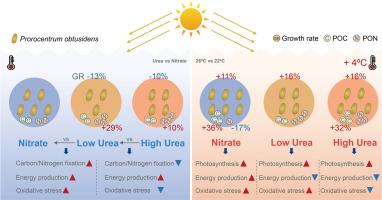引起藻华的鞭毛原藻对高温和尿素的反应
IF 4.5
1区 生物学
Q1 MARINE & FRESHWATER BIOLOGY
引用次数: 0
摘要
升高的温度和氮(N)有效性对鞭毛藻的影响不同;然而,它们的相互作用在很大程度上仍未被探索。本研究研究了在3种N浓度(16 μM硝酸盐、8和16 μM尿素)条件下,对22°C和26°C的高温(22°C和26°C)暴露32天后的生理和转录组反应。在所有的N条件下,升高的温度都促进了细胞的生长,尽管温度和N之间的相互作用不明显,但尿素生长的细胞的增长更为明显。硝酸盐培养的细胞颗粒有机碳(POC)含量、碳氮比、核酮糖-1,5-二磷酸羧化酶/加氧酶(RubisCO)、磷酸烯醇丙酮酸羧激酶和脲酶活性较高,颗粒有机氮(PON)含量较低。低尿素培养的细胞C:N比、总碳水化合物含量、碳酸酐酶(CA)、谷氨酰胺合成酶(GS)和脲酶活性较高,但磷酸烯醇丙酮酸羧化酶活性、总蛋白和总抗氧化能力较低。高尿素培养的细胞表现出更高的最大光合效率、POC含量、C:N比以及CA、RubisCO、GS和脲酶活性。转录组学分析显示,在所有氮条件下,温度升高均增加了光合作用相关基因的表达。硝酸盐生长的细胞产生更多的能量来缓解热应激,而尿素生长的细胞则减少能量产生。这些发现表明,当与尿素一起生长时,P. obtusidens对未来海洋变暖的适应能力更强,并且预测鞭毛藻对变暖海洋的反应应考虑环境中的N条件。本文章由计算机程序翻译,如有差异,请以英文原文为准。

Responses of a harmful algal bloom-causing dinoflagellate Prorocentrum obtusidens to elevated temperature and urea
Elevated temperature and nitrogen (N) availability affect dinoflagellates differently; however, their interactive effects remain largely unexplored. This study investigated the physiological and transcriptomic responses of a harmful algal bloom-causing dinoflagellate, Prorocentrum obtusidens, to elevated temperature (22 °C vs. 26 °C) under three N conditions (16 μM nitrate, 8 and 16 μM urea) after 32 days of exposure. Elevated temperature enhanced cell growth across all N conditions, with a more pronounced increase in urea-grown cells, regardless of the insignificant interaction between temperature and N. Physiological responses to elevated temperature varied under N conditions. The nitrate-grown cells had higher particulate organic carbon (POC) content, C:N ratio, and activities of ribulose-1,5-bisphosphate carboxylase/oxygenase (RubisCO), phosphoenolpyruvate carboxykinase, and urease, but lower particulate organic N (PON) content. The low urea-grown cells showed higher C:N ratio, total carbohydrate content, and activities of carbonic anhydrase (CA), glutamine synthetase (GS), and urease, but lower phosphoenolpyruvate carboxylase activity, total protein, and total antioxidant capacity. The high urea-grown cells exhibited higher maximum photosynthetic efficiency, POC content, C:N ratio, and activities of CA, RubisCO, GS, and urease. Transcriptomic analysis revealed that elevated temperature increased the expression of genes associated with photosynthesis under all N conditions. The nitrate-grown cells produced more energy to mitigate thermal stress, whereas the urea-grown cells decreased energy production. These findings suggest that P. obtusidens is more resilient to future ocean warming when grown with urea, and predictions of dinoflagellate responses to warming oceans should consider N conditions in the environment.
求助全文
通过发布文献求助,成功后即可免费获取论文全文。
去求助
来源期刊

Harmful Algae
生物-海洋与淡水生物学
CiteScore
12.50
自引率
15.20%
发文量
122
审稿时长
7.5 months
期刊介绍:
This journal provides a forum to promote knowledge of harmful microalgae and macroalgae, including cyanobacteria, as well as monitoring, management and control of these organisms.
 求助内容:
求助内容: 应助结果提醒方式:
应助结果提醒方式:


